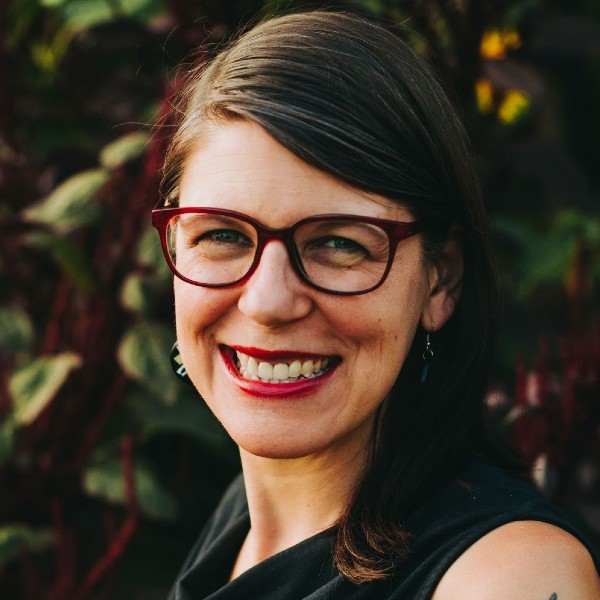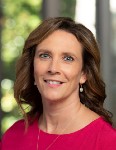Millennials are less religiously affiliated than ever before. Yet they also say they are spiritual. In what places are these young adults finding spiritual connection -- and how could those secular communities engage with institutional religion?
That’s the question that animates the work of Angie Thurston and her co-author, Casper ter Kuile, both Ministry Innovation fellows at Harvard Divinity School.
“Our goal is to help bring as much of America as possible into robust and life-giving spiritual communities, whatever shape that takes,” Thurston said. “And so it seems that a conversation between the institutions of religion and the fledgling emerging landscape is important.”
Thurston and ter Kuile have studied hundreds of organizations, secular and sacred, that attract millennials, and have mapped six recurring themes that they share: community, personal transformation, social transformation, purpose finding, creativity and accountability.
Their first report, “How We Gather,” looks at secular organizations, including fitness-oriented groups such as SoulCycle and CrossFit; spiritual wellness organizations such as The Sanctuaries and Juniper Path; and advocacy groups such as Ctznwell.
In a follow-up report called “Something More,” the authors examine innovative religious communities, including Pop-Up Shabbat, Buddhist Geeks, the Neighborhood Halaqa, and Relevant Media Group, an evangelical Christian magazine and online platform.
Thurston spoke to Faith & Leadership about both reports. The following is an edited transcript.
Q: What attitude do you hope the church adopts toward these secular expressions of community?
I would hope the church adopts an attitude of curiosity above all.
Casper and I came to discover that often the experiences in the organizations went dramatically beyond their primary focus.
You’d have an organization that was focused ostensibly on something like physical fitness or well-being, but the experiences people were having there had more to do with personal growth and transformation, and a connection with a sense of purpose in their life, a sense that they were part of something bigger than themselves.
So how might those communities, as they’re currently taking shape, connect to the long legacy of religious traditions?
Q: What questions should church leaders be asking about these communities?
What are the needs that participants may have when it comes to living a robust and spirit-filled life?
If something like CrossFit or SoulCycle is someone’s primary experience of community and they are finding it to be meaningful, then you can ask questions like, “Where does somebody go when they lose a loved one, or when somebody that they care about is diagnosed with an illness, or even when they want to celebrate something like a marriage or the birth of a child?”
In many cases, people participating in these communities are not also participants in religious communities.
But in many cases, it is not a rejection of religious communities that they’ve actually experienced in their own life. It’s often an experience of being unchurched or unhoused religiously, or only peripherally involved in a religious community. They just feel that it’s irrelevant to their life.
There’s a real disconnect between the gifts that these traditions have to give and a lot of the people that they could be giving them to.
Q: What do you think churches can teach, and what can they learn?
There is such a yearning among the unaffiliated for places that they can go to become the people that they want to be. As a result of not being churched, I think a lot of these people don’t trust religious institutions to be those places.
Casper and I have been amazed to discover how open the leaders of these communities are to finding some kind of mentor or guide who can work with them as they navigate the vicissitudes of community leadership. They are really desirous of some spiritual direction along that path.
All of that is work that church communities have been doing for thousands of years. And there are so many gifts that organizations that have come through that experience could offer to this fledgling landscape.
But I will also say that, as a caveat, these people in general can smell evangelism a mile away. And it’s not necessarily going to look like them becoming Methodist or becoming Lutheran or taking on that identity, at least in the short term.
But if the church were to come offering the gifts that respond to direct needs of the community leaders and participants -- of which there are many -- I think there’s a real potential for bridge building.
Q: Is your emphasis on bringing the lessons of the church to the secular organizations, or is it more of an equal learning?
Our goal is to help bring as much of America as possible into robust and life-giving spiritual communities, whatever shape that takes.
And so it seems that a conversation between the institutions of religion and the fledgling emerging landscape is important.
I’m personally invested in this landscape of innovation because it seems that it’s drawing people and growing, regardless of whatever opinions we may have about that happening.
Neither Casper nor I came out of an institutional religious context. And so it’s something that we learned in the last few years as we’ve been doing this work. It’s been a really incredible and wonderful journey for the two of us, to get to know the gifts that are so abundant in the church.
I think that story is, or could be, a bit of a microcosm for what’s possible in this larger landscape.
But again, I don’t think saying it louder in different language is going to achieve that goal. It really has more to do with developing relationship. That’s where we’ve seen it work.
Q: In the conclusion of the “Something More” report, you note the strained relationship between innovative religious communities and their denominations. Have you given thought to bridging that particular divide?
We plan to have a convening of denominational staff across 11 different denominations -- Christian, Jewish and Unitarian Universalist -- and invite them into a conversation about their role in relationship to this ecosystem of innovation, both within their own denominational contexts and then across the broader landscape.
Because Casper and I are not the ones doing the work of community leadership, we really want to hear it from the leaders themselves. To ask, “What would be of service to you now in the work you’re doing?” and then to be able to have that conversation, and for denominational leaders to be able to have that conversation with each other.
The gathering that Casper and I went to at TMF [Texas Methodist Foundation] sort of set a tone for us. We have now found ourselves in a number of rooms with denominational staff across different traditions, different denominations.
It’s become a lot clearer in the process of being in those rooms why there might be strain when some 21-year-old upstart says, “Hey! I’m just going to go make a community, right?” to somebody who did all the religious studies, who went through seminary and learned all the languages, and was sent somewhere by their denomination to plant a church and did so, and pastored that church for 30 years, and raised their family and sent their kids to college, through no small effort, based on working in that kind of leadership, only to see their congregation start to decline as part of this larger phenomenon we’re seeing.
That evokes a lot of feeling when that’s a story that you’ve experienced.
So it’s been helpful for us to get to hear from people who have dedicated their lives to religious leadership within denominations and the institutional structures, and then to try to understand how, given all of that, there might be room to sort of release all the stored gifts that can come from a life of service in that capacity.
Q: What was the response from the TMF group? You were talking about community in a different way than what they’re used to.
We found ourselves as -- hopefully -- loving outsiders and somewhat as provocateurs, but not for the sake of provocation.
We were there simply to say, “Here is something that’s going on, and we’ve observed it and attempted to write about it in a way that starts a conversation, or helps a conversation to grow.”
And so it’s hopefully an invitation to be in that conversation. It doesn’t even have to be with us, but just to offer a perspective on a landscape that’s new, and to shed light on some of the perspectives within that landscape.
For example, we showed this SoulCycle promotional video for a new app, which is called #OhAppyDay, that parodies the song “Oh Happy Day.” In the video, people walk into a SoulCycle studio as a robed gospel choir sings in the back. There were audible gasps in the room.
But the point we were trying to make was simply that (a) this is happening -- however we feel about it, it’s happening -- and (b) when SoulCycle was thinking about the audience to whom they’re promoting their new app, they weren’t trying to provoke with that video; they were just using a peppy song in order to promote something that people would be excited about.
So we were trying to drive home what it feels like to be unchurched, and the fact that that song was probably unfamiliar to most of their clientele, and it wouldn’t occur to them to be offended by its use in the context of something like marketing a new product.
Q: What’s the middle ground between organizations like SoulCycle and the United Methodist Church? What could be the connection there where they might benefit from each other?
I would say it has something to do with the journey toward greater spiritual depth.
One of the things that really needs to be worked on is a language barrier. A lot of the words are so laden at this point that you have the majority of the unaffiliated self-identifying as nothing in particular, even if they believe in God or a higher power.
When the language that is being used by those who are part of an institutional church context is language that somebody in a SoulCycle class can’t even hear, then there can be a sort of baby-out-with-the-bathwater response.
How can we find a shared language that actually honors the faith journeys of both somebody who is unaffiliated and somebody who is strongly identified with a particular faith tradition?
Q: Talk about the “Something More” report. What innovations are you finding in the religious community?
As an overarching statement, I would say that often the innovative religious communities resemble the communities we profiled in “How We Gather” more than they do their own institutional mainstream.
The reason we called that report “Something More” was because there is a greater interest in engaging that which grounds our being. Some of these communities call that “God,” and some of them don’t.
But there’s this gesture toward something more -- toward something transcendent, something that is in some way bigger than us. It gives us an alternative to a place of material culture in which your value is your capacity to consume.
But they don’t necessarily have language or tradition that speaks to what makes them valuable as a person on a bigger scale and what that might have to do with God.
Q: You also note that being in seminary made you realize how much training goes into that role of being a pastor or minister, and these folks are providing what might be called pastoral care without the training.
They certainly take it seriously, but they are largely untrained. It’s the rare person within a secular community who has explicit spiritual care and counseling, pastoral care and ministry training.
What we’re hoping to do is resource those leaders, because we do think that the responsibility they’re bearing is significant, especially as the disaffiliation trend continues.
Part of the irony of it is that even though they’re leading communities, they’re often doing it in relative isolation.
And so it’s important for them to have peers across a landscape, to be able to say, “I see the commonality in our work, and I see how I could both teach and learn across this landscape.”
And then also just to have it witnessed and honored, which is something that, if you don’t have a bishop and you don’t have a denominational structure, often doesn’t happen.
And there are also the negative possibilities of what can happen when you’re not being seen and supervised and cared for, with some guidance by people who have been there before.












